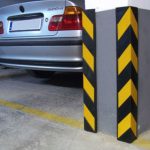Introduction
Traffic management is a critical aspect of road safety, and one of the most common tools used for this purpose is the rubber speed bump. These devices are designed to control the speed of vehicles, particularly in residential areas, near schools, and other high-traffic locations. However, the installation and use of rubber speed bumps are not a one-size-fits-all solution. Several factors need to be considered to maximize their effectiveness. This article provides a comprehensive guide on the different types of rubber speed bumps, their advantages and disadvantages, tips for optimizing their use, and guidance on their correct installation.
Understanding Rubber Speed Bumps
Rubber speed bumps are traffic calming devices that use vertical deflection to slow down vehicles, thereby improving safety conditions. They are made from a variety of materials, including asphalt, concrete, recycled plastic, metal, or vulcanized rubber. Rubber wheel chocks are pre-shaped to standard sizes to meet industry standards and are typically bolted down, making them easier to install or remove. This feature makes them ideal for testing the use and positioning of speed bumps before implementing them in larger projects.
Advantages and Disadvantages of Rubber Speed Bumps
Rubber speed bumps offer several advantages. They are durable, easy to install, and effective at slowing down traffic. However, they also have some disadvantages. For instance, they can increase traffic noise, may damage vehicles if traversed at high speeds, and can slow down emergency vehicles. Furthermore, poorly designed speed bumps that are too tall or have too sharp an angle can be disruptive for drivers and may be difficult to navigate for vehicles with low ground clearance.
Optimizing the Use of Rubber Speed Bumps
To maximize the effectiveness of rubber speed bumps, it’s crucial to consider their placement and design. They should be installed in areas where low speeds are desired and suitable for the surrounding traffic environment. They are typically placed on residential roads and are not used on major roads, bus routes, or primary emergency response routes. Placement is generally mid-block between intersections. Additionally, the design of the speed bump should be such that it effectively slows down vehicles without causing unnecessary disruption or damage.
Conclusion
Rubber speed bumps are a valuable tool for managing traffic speed and ensuring road safety. By understanding their types, advantages, disadvantages, and optimal usage, municipalities and other entities can make informed decisions about their installation and use. With the right approach, rubber speed bumps can significantly contribute to safer roads for drivers and pedestrians alike.





